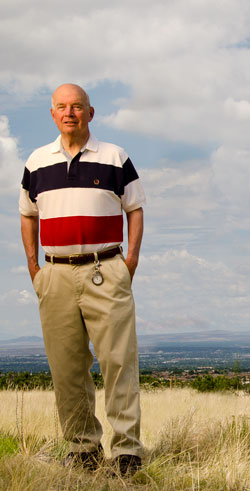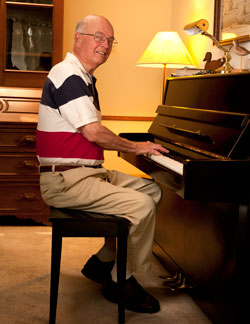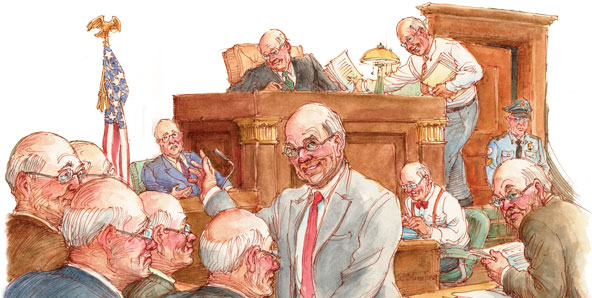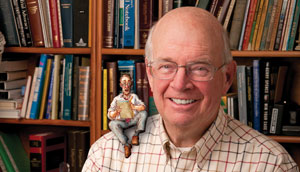The World of McElhaney: Jim McElhaney Closes the Book on a Storied Career, But Angus Lives on

Photo of Jim McElhaney by Douglas Merriam.
If anyone is in a position to explain the essence of what makes Jim McElhaney tick, it might well be Steven J. Miller.
After starting law school at Vanderbilt University in Nashville, Tenn., Miller transferred in 1979 to Case Western Reserve University School of Law in his native Cleveland, where McElhaney was building a national reputation as a trial advocacy teacher. Miller introduced himself, “and from that moment he became my mentor. He was a very engaging, knowledgeable guy, and we hit it off.”
Miller took every trial advocacy course that McElhaney taught. “He helped people learning to think like a lawyer to talk like a human being,” says Miller, the managing partner at Miller Goler Faeges Lapine in Cleveland. “Jim knew that juries were still people. He knew that you reach people in their guts and their hearts, and not just in their brains.”
Miller, along with other local trial attorneys, later would help out with some of those classes. McElhaney also recruited Miller to write for Litigation, a quarterly journal that had been launched a few years earlier by the ABA Section of Litigation. McElhaney even would call Miller and read to him the drafts of his own column in the publication. (Miller still serves as an associate editor for Litigation.)
Miller says local practitioners and students alike treated McElhaney’s continuing education lectures as events. “It was like going to see Frank Sinatra,” he says. “We’d go to hear Jim over and over. He was a professional and a human phenomenon.”
McElhaney arguably is the most influential teacher of trial advocacy in the past half-century. But if you ask Miller how McElhaney gained all his knowledge on the subject and developed his unique skills at sharing it with others, he stumbles.
“When I’m 80, and people ask me where I gained my wisdom, I can say it came from McElhaney,” says Miller. “But where he got it, I’m afraid I just don’t know.”
A cursory look at McElhaney’s legal career doesn’t offer any easy clues to the source of his genius—and it is fair to use that term—as a teacher in the trial advocacy field. It does, however, reveal some interesting paradoxes.
AN UNASSUMING ASCENT
The law schools where he taught during his 35-year academic career are not in the pantheon of the nation’s most prestigious centers of legal scholarship—and he probably wouldn’t have it any other way.
The most time he spent as a practicing attorney was during a four-year stint in the Army’s Judge Advocate General Corps in the early 1960s. His contribution of articles published in academic legal journals—the ones with all the footnotes —is almost nonexistent. Except for his Army years, his base of operations has never been one of the centers of the U.S. legal profession, like New York City or Washington, D.C. For the past 10 years, he and his wife, Penny, have lived in New Mexico, splitting their time between a log cabin they built in Chama just south of the Colorado border and a small house in the foothills of the Sandia Mountains on the eastern edge of Albuquerque.
But McElhaney’s impact on trial practitioners in the United States has nevertheless been profound.
Video: McElhaney discusses using simple language in the courtroom.
“He became the mentor for so many students who went on to become influential lawyers,” says Arlene Hrisko, his secretary at Case Western from 1978 until he retired from teaching and left for New Mexico in 2002. “He was a good guide for them, and always valued what they had to say.”
While at Case Western, McElhaney was one of the country’s first law professors teaching litigation skills to receive an endowed chair, and he helped trial advocacy gain credibility as part of the curriculum for law schools.
Moreover, he was one of the most popular faculty members at the National Institute for Trial Advocacy in Boulder, Colo., from 1975 until he struck out on his own as a freelance trial skills instructor in the late 1990s. His programs became so popular that for a while he was on the road almost every weekend.
David A. Schaefer, who began teaching NITA programs with a supportive nudge from McElhaney, remembers vividly the effect McElhaney had on one audience of some 300 lawyers at NITA headquarters in Denver. “He had every single person in the room spellbound,” says Schaefer, the senior partner in the litigation trial group at McCarthy, Lebit, Crystal & Liffman in Cleveland. “He was dynamic, he was humorous. He was absolutely fantastic. There weren’t cellphones or iPhones in those days, but if there were, no one would have theirs on.”
But it is McElhaney’s writing that most sets him apart from his peers in the trial advocacy field. McElhaney wrote the Trial Notebook column in every issue of the quarterly Litigation journal from its inception in 1975 until 2006. Then in October 1987, McElhaney began writing the monthly Litigation column for the ABA Journal, and he didn’t end his run until publishing his last original column in September 2011. Discounting for some reprints published in recent years, that represents an output of more than 260 columns over the past quarter century.
It was the Litigation column, of course, in which McElhaney introduced his version of William Faulkner’s Yoknapatawpha County. McElhaney’s fictional legal community never had a geography, but it was inhabited by a cast of characters whose names sometimes had a tinge of Dickens to them: Judge Horatio Standwell, Beth Golden, Dick Mudger, the twitty bar politician Myra Hebert and “Tricky” Strickland, who left the monolithic Windstrom & Crusher to start his own firm. The wizened sage at the heart of the group was, of course, Angus—always just Angus—who presided at spots near the courthouse such as the Donut Hole, the First Federal Soup and Sandwich Shop, and Zapata’s Chili House.
“Jim’s writing is a combination of clarity and simplicity,” says Christopher T. Lutz, a partner at Steptoe & Johnson in Washington, D.C., who is editing a second compilation of McElhaney’s columns from the ABA Journal that is scheduled to be published next year. “His writing is very stylish, but very accessible. It’s so easy to read that you think it’s that easy to write.”
The first collection of McElhaney’s Journal columns—McElhaney’s Litigation, published in 1995—and his collection of articles from the Litigation journal—McElhaney’s Trial Notebook (fourth edition)—still are in print and available through ABA Publishing.
McElhaney “is a major, major figure,” says Lutz, who served two terms as editor-in-chief of Litigation and is a past member of the ABA Journal Board of Editors. “The only other trial practice teacher who made an impact like that was Irving Younger, and for a much shorter time.” Younger, who became legendary for his presentations on evidence, trial practice and civil procedure, died in 1988 at the age of 55. But while Younger was a pathfinder in the field of trial practice education, “Jim has taken it farther on an individual level than maybe anyone else I know,” says Douglas D. Connah Jr., an early student of McElhaney’s at the University of Maryland School of Law in Baltimore who later recruited McElhaney to work on Litigation. “There’s probably hardly a lawyer who does trial work in this country who doesn’t know McElhaney, and that’s quite an accomplishment.”

McElhaney still occasionally plays piano. Photo by Douglas Merriam.
THE PATH NOT TRAVELED
If things had been up to McElhaney, music might have been his career choice. “I dreamed of having a big band,” he says.
McElhaney’s parents lived just outside New York City in Tarrytown in 1937, the year Jim was born, but the family soon moved to Shorewood, Wis. Even back then, Shorewood was one of Milwaukee’s more tony suburbs, but he remembers that the family lived in a modest duplex. His father was a traveling salesman, and his mother taught art and home economics in the local schools. He started playing cornet in the fifth grade. In high school, he played tuba in the marching band. He also taught himself to play the piano, and he performed with a dance band called the Star Dusters.
A visitor to the McElhaney home in Albuquerque can quickly see that music still is one of his passions. An upright piano dominates the cozy living room, and McElhaney is quick to sit down and play a very respectable version of an old standard, “Stars Fell on Alabama.” During a recent visit by this reporter, he even was prodded into playing and singing part of a song he wrote himself for a college musical. It’s a charming little ballad called “I Nominate Me.”
There’s little evidence of McElhaney’s illustrious legal career at the house—he says most of the diplomas, awards and other stuff is still up at the cabin in Chama. A few law books sit on a shelf in his office, and a framed drawing by John Schmelzer, the artist who created many of the illustrations for McElhaney’s columns in the ABA Journal, hangs on a wall. It depicts one of McElhaney’s most memorable creations: Mongo, the inner beast in every lawyer who wants to make every trial a combat to the death.
But attached to the inside of the office door is a laminated page from the March 9, 1956, issue of Shorewood Ripples with an article about the Star Dusters. There also is a business card that reads “Modern music styled by the Star Dusters.” The card has McElhaney’s name on it and his phone number: FLagstand 2-8415.
“It’s funny how some people’s talents come to the fore in different areas,” says John H. McElhaney, who at 77 is Jim’s older brother by three years. John is of counsel at Locke Lord in Dallas.
“I took some clarinet lessons, and I was horrible,” says John. “But Jim was very much taken by Glenn Miller and all that.”
John recalls that on a recent visit to see Jim and Penny, they described a trip back to Shorewood for his 50th high school reunion, where Jim reorganized his band for an informal performance. One of the musicians had gone on to Harvard Law School, then became a tax expert at one of Boston’s leading firms. Years before, John was working with an insurance carrier who insisted, by coincidence, that he retain Jim’s old classmate to consult on some tax questions. “I said, ‘I know this guy,’ ” says John. “ ‘He was in my brother’s band!’ ” But at the reunion, Jim couldn’t have cared less about the classmate’s tax law expertise. “Jim was more concerned about whether he could still play,” says John.
John thinks music may have had an influence on the choices Jim later made in his legal career. “His love of performing was central to that,” says John. “He loved being in the spotlight.”

Illustration by John Schmelzer.
LAW COMES CALLING
Getting into college was a lot different in the 1950s than it is today. Jim was all set to attend the University of Wisconsin in Madison until he was called into his high school dean’s office one day to meet a representative from Duke University, who offered him an academic scholarship on the spot.
“I thought Duke was a neat place,” says McElhaney, “although Durham wasn’t much, a small town. Chapel Hill was the fun town.”
But Duke was where McElhaney’s musical aspirations turned into bits of stardust. “The Duke Ambassadors were already there, and they blew everybody away,” he says. “I was good, but I wasn’t that good, and I went on to other things.”
One of those things was law school. After receiving his undergraduate degree, McElhaney entered Duke’s School of Law. “My brother was already in law school, and it sounded like a neat idea,” he says. “I thought about medicine, but it was a longer haul. It’s a choice I’ve never regretted. The desire for justice and fairness is elemental. If you have it, the choice of law seems obvious.”
Jim was in law school when he met Penny—her formal name is Maxine—who was living in the nursing dorm right across the street from the men’s graduate center, where he lived. They got married during the summer after his second year.
But Penny says they got off to a bit of a rocky start. “On our first date, he was late getting to the nurses’ dorm,” she says. “I was a little peeved, but when he said, ‘I had trouble finding the place,’ it broke the ice. Then when we went to a restaurant, I ordered chicken livers, and Jim couldn’t believe anyone would order that.”
After McElhaney graduated from law school, he and Penny applied for the Peace Corps, but they never got a response. Instead, he was drafted into the Army and joined the JAG Corps. “I preferred carrying a law book for three years to carrying a rifle in Vietnam,” he says.
He was assigned to the headquarters of the First Army on Governors Island in New York City. “I was just a regular guy doing regular work with nine other lawyers,” he says. He did some prosecution work and also served as legal adviser to the colonel responsible for administrative matters on the island, reaching the rank of captain.
The Army asked McElhaney to re-up, but he decided against it. “The plan was to go back to Milwaukee and join a law firm,” he says. So in January 1966, he became an associate at Wickham, Borgelt, Skogstad & Powell (now Borgelt, Powell, Peterson & Frauen). He left within six months.
“I wasn’t enamored with the law firm environment,” says McElhaney. “I thought it would be more fun to teach.”
John McElhaney recalls that he and his brother had different views on practicing law. “For me,” he says, “there was never much hand-wringing. Law school was something that would lead to a good, solid profession. But I think Jim really didn’t like the atmosphere of being a young lawyer who would have to be the lackey for the senior partners. That goes with his mentality of wanting to be in charge.”
As Jim began his search for a teaching post, he was contacted by Garrett Power, a classmate at Duke, who invited him to come out to the University of Maryland School of Law, where Power had joined the faculty (and still teaches as a professor emeritus). “By the time we got home,” McElhaney says, “there was an invite to join the faculty at the University of Maryland, and we hopped on it in a New York minute.”
Starting at Maryland in the fall of 1966, McElhaney taught contracts, a seminar on law and poverty and, in a somewhat unusual move, trial advocacy.
“Usually, they hired practitioners to do that,” he says. “I was one of the first academic types to teach trial advocacy, which was just then starting to take off.”
Connah became a law student at Maryland during McElhaney’s first year teaching there. He was more grizzled than the other 1Ls, having worked a decade as a newspaper reporter and serving in the military. When he signed up for McElhaney’s trial advocacy course, it was the start of a long-lasting professional and personal friendship.
“I was interested in trial law, but he was a good teacher,” Connah says. “He had already developed his own style. He was a natural-born teacher. He had a sense of irony and playfulness. He was as far from Professor Kingsfield in The Paper Chase as you could get.”
McElhaney says the most important thing about his teaching style “is that I didn’t want to sound like an academic. I still don’t.”
But he also didn’t want to sound like a lawyer. “I want to sound like a regular person,” he says. “I want everything I express to do so cleanly, clearly and simply. Law schools teach you to talk funny, and lawyers want to sound ‘special’ coming out of the law school environment. I was so happy to spend my academic life talking like a normal person.”
After seven years at Maryland, McElhaney joined the law school faculty at Southern Methodist University in Dallas. By that time, he and Penny had two young sons. His parents were living in Dallas by then, and his brother had an established law practice there.
During McElhaney’s three years at SMU, “he was a very popular professor, and he’s remembered very fondly by local lawyers from that era,” says John McElhaney. “He was probably the most popular lecturer that SMU ever had. But he didn’t teach trial advocacy. It wasn’t considered a legitimate thing for a law professor to be involved in.”
But the traditional academic route never suited Jim McElhaney. “He got into academia through performance more than writing formal articles,” says John. “He never really did that kind of writing. He was enough of an iconoclast to feel strongly about that.”
That’s what made the offer from Case Western Reserve University in Cleveland so attractive, McElhaney says. The school promised him a lot of flexibility in setting up his own trial advocacy program, as well as to give it credibility as part of the curriculum. He would receive an endowed chair, the first in the United States, he says, to be held by a trial advocacy teacher. “And I would also teach conflicts of law to establish credibility with my fellow faculty members,” he says, “because conflicts is real lawyer’s law.”
So McElhaney joined Case Western in 1976 and soon after became the Joseph C. Hostetler Professor of Trial Practice and Advocacy, a chair created by the widow of one of the founders of the firm that is now Baker & Hostetler. Case Western would be his academic home until he retired from active teaching in 2002.
McElhaney’s program called for a small number of students to meet weekly to study the various steps of a trial in the order in which they would unfold. The program was heavy on interactions and critiques, and the final exam called for the students to pair up and argue a case against another team. At the time, it was a novel approach.
An important element that McElhaney brought to the course was a strong sense of core principles, says former student Miller. “He pushed for us to find the words that reflected a moral code, a value system and a sense of injustice. He knew that people want to play a role in righting a wrong.”

Photo of Jim McElheney by Rick Allred, illustration by John Schmelzer.
ENTER ANGUS
At just about the same time that McElhaney arrived at Case Western, the opportunity opened up to reach another audience with his ideas about effective trial advocacy.
In the early 1970s, the new Section of Litigation wanted to create some publications for members. Two of the committee members charged with that task were Connah and the late Charles Wilson, who had known each other when they were journalism students at Columbia University before they became attorneys. One of the magazines they envisioned was a quarterly publication with practical articles for practitioners, simply called Litigation. As Connah remembers those initial discussions, Wilson suggested a department called Back to Basics, in which different litigators would write about various trial techniques.
Video: McElhaney on the origin of Angus.
Connah suggested that his friend McElhaney would be a good choice to serve as an associate editor responsible for Back to Basics. McElhaney took the gig. “We never thought we were recruiting someone to write the column himself,” Connah says, “but I suspect that was his agenda all along.” By the time the first issue of Litigation was published in the winter of 1975, the column had been renamed Trial Notebook. McElhaney wrote the first installment, and every other one, as well, until calling it quits with the winter 2006 issue. (McElhaney also served as editor-in-chief of Litigation from 1984 to ’86.)
“Jim was very important for Litigation magazine, and the Litigation Section” says Connah. “He became hugely popular. The magazine was one of the engines of the section’s growth, and Jim was the most visible contributor to the magazine.”
In 1987, McElhaney added the ABA Journal to his arsenal. It was a happy arrangement for both parties. According to readership surveys, McElhaney’s Litigation column remained one of the most popular articles in the magazine for 25 years. Meanwhile, McElhaney was able to reach a broad audience of practicing lawyers with his columns in the Journal and Litigation.
“Putting Jim McElhaney in the magazine turned out to be one of the smartest decisions I ever made,” says Larry Bodine, who was then editor and publisher of the ABA Journal, and who now is editor-in-chief of Lawyers.com.
“Jim managed to develop between five and 10 common themes” for trial lawyers to follow, says Lutz of Steptoe & Johnson. “But what struck me is that he made it all seem possible. With Younger, you’d think, ‘Hey, this guy is brilliant, but I could never do that.’ The beauty with Jim is that he made you think, ‘Hey, I can do that.’ In his tremendously entertaining way, he gave people advice they could use.”
Another reason for McElhaney’s enduring popularity, Lutz suggests, is that “he was a little cheeky—a lot cheeky, really—about the legal profession. He gave serious advice, but he didn’t take himself too seriously. I think younger lawyers especially like that.”
A key element of McElhaney’s philosophy is the conviction that good trial lawyers must be effective storytellers. “Stories are how we understand the interrelationship of events,” he says. “Stories are at the heart of how we learn because they create memories and provide details we want to know. Stories grab us in a way that no list of facts could ever do. So why would you make your story difficult to follow?”
That may explain why he introduced Angus and friends into his columns for the Journal. McElhaney himself is somewhat coy about the genesis of his popular character. “I needed a guru, and he became my guru,” McElhaney says. “I picked the name because I liked it. It didn’t mean anything, but it was distinctive and stood out as a single name. Maybe that’s why everyone feels they know Angus.”
Lutz has another theory. “Jim had his characters, and there was a Jimmy in many of the columns, but there’s no doubt in my mind that he saw himself as Angus.”
One aspect to McElhaney’s approach to writing has an almost 19th century quaintness to it. He strongly believes that writing can be improved dramatically by reading it aloud. His wife, for instance, has heard every column he wrote for the ABA publications. “He would read it aloud to me, but that also helped him see things he didn’t like,” she says.
McElhaney’s former secretary Hrisko also was a regular audience for his reading sessions. “Every time he got an article ready to send, he would read it to me,” she says. “Sometimes I would ask where he got his ideas, and he’d always say, ‘It’s in the noodle.’ ”

Photo of Penny and Jim McElhaney by Douglas Merriam.
FINAL WORDS
Jim McElhaney’s world is getting a little smaller these days. He and Penny spend most of their time in Albuquerque now, and they don’t get up to the cabin in Chama as much as they’d like. But the Albuquerque place “is an easy house for old folks,” Penny says. Besides, it’s easier to see doctors in Albuquerque for medical issues that have begun to pop up, and their son David, a personal trainer in town, comes by every day or so and has them lift weights. When they do travel, it’s often to visit their other son, Ben, a computer programmer in Columbus, Ohio, and family, including their first granddaughter, Sophie.
McElhaney hasn’t done any law school teaching since 2002, when they moved to New Mexico. The column in Litigation ended in 2006. He gave his last CLE program in November 2010, right in Albuquerque, and now his 25-year run at the ABA Journal is over, as well.
So is McElhaney retired? “I think so,” says Penny, and he nods in agreement. “I don’t feel any great need to write anymore,” he says. “I enjoy it, but I did a lot of it.”
For the better part of 50 years, McElhaney has been the dominant voice in teaching trial advocacy to law students and practicing attorneys in the United States. In his unique and special way, he has said exactly what he wanted to say on the subject. And now he’s done.



